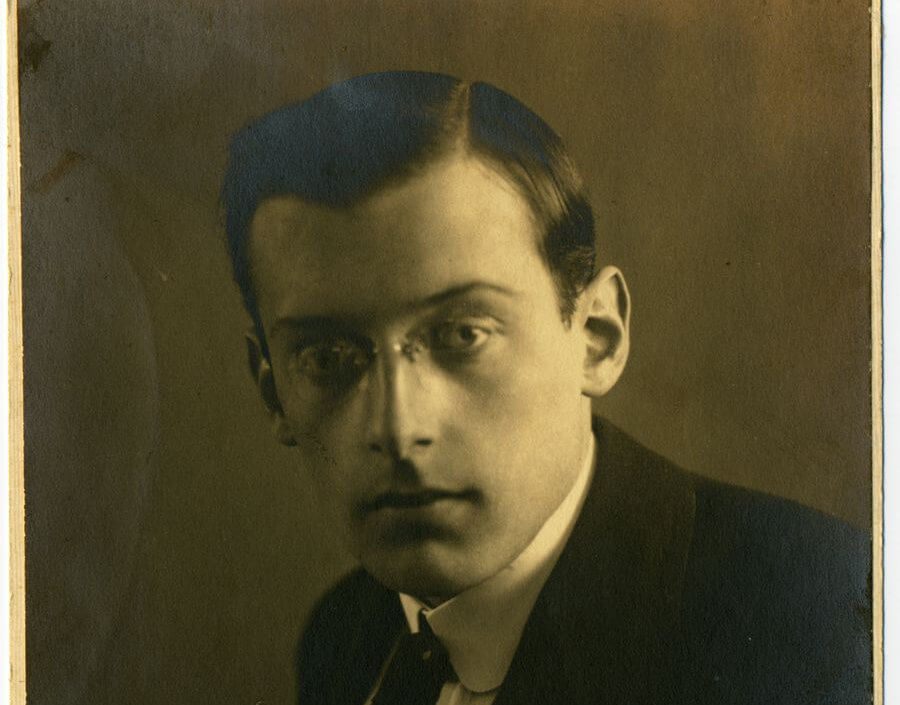[vc_row][vc_column width=”1/6″][/vc_column][vc_column column_width_percent=”100″ gutter_size=”3″ overlay_alpha=”50″ shift_x=”0″ shift_y=”0″ shift_y_down=”0″ z_index=”0″ medium_width=”0″ mobile_width=”0″ width=”2/3″][vc_column_text]
THOUGHTS ON THE EARLY WORKS OF PAUL BEN-HAIM (FRANKENBURGER)
from Michael Wolpe
Born in Munich, Germany
The composer Paul Ben-Haim (1897-1984) was born as Paul Frankenburger in the city of Munich, the capital city of Bavaria, where he became an active and quite successful composer after World War I. In a dialogue between him and his biographer, Prof. Jehoash Hirschberg, Ben-Haim described the jewish community in Munich as a large and culturally active community. From his description, as well as those of many historians who researched the history of German Jewry in modern times, the Jews in Bavaria, like most German Jews of that time, were partly assimilated, although quite a few sought to preserve their jewish identity. Those who upheld jewish tradition, were divided into Orthodox and Liberal (more specifically Conservative and Reform). Bavarian Jews, for the most part, were German patriots, and as such participated in the war effort, and many even excelled as soldiers on the battlefield. Paul Ben-Haim personally experienced the horrors of the war, and they greatly influenced him.
A deep friendship between Frankenburger and Heinrich Schalit
After Ben-Haim‘s return from the war, he immediately returned to his professional and artistic work as a composer and conductor, both in his hometown of Munich, and later in Augsburg. During those years, a deep friendship was formed between Frankenburger and the jewish German composer Heinrich Schalit (1886-1976). As Ben-Haim himself described it in Hirschberg‘s book, Schalit was the more experienced composer, and most of his musical productivity was influenced by his jewish education and background, as well as his interest in the Zionist movement.
Schalit composed a large body of liturgical music
Schalit composed a large body of liturgical music for Mu- nich‘s liberal synagogues. He sought to create a new style- different from the styles of Lewandowski and Sulzer- which would not be an imitation of European ecclesiastical music. Instead, he turned to the origins of jewish music as an inspi- ration to his „New Jewish Music Style“. He was well acquain- ted with the Biblical Cantillation (in Hebrew: “Te‘a‘mim”) of several jewish traditions, including both Ashkenazic and Sephardic, as well jewish scales, also known as “Steiger”, and created a personal musical language based on mo- des close to the Hijaz scales of the Spanish Jews, and the „A‘hava Raba“ („A Great Love“) mode of Chassidic music. He even wrote about his artistic vision and about his individual technique in an article, published in 1931 2.
Schalit influenced young Frankenburger
Heinrich Schalit‘s ideas greatly influenced the young Franken- burger. Schalit, who served as an organist and composer for the Great Synagogue in Munich, invited his young friend to write a number of works for the synagogue. These liturgical works remain in the National Library of Israel, at the Hebrew University in Jerusalem. Among these works are „Psalm Chapter 12“ for four soloists, mixed choir and orchestra, written in 1923; „Three Motets“ based on texts from Isaiah and Job, for mixed choir, composed in 1928, and other works based on the book of Psalms, the book of Ecclesiastes and the book of Isaiah. All these compositions were written during the late 1920s and early 1930s.
Heinrich Schalit‘s son, Michael Schalit, who wrote his father‘s biography, is convinced of his father‘s desire to involve his friend Frankenburger in the synagogue‘s musical activities. According to Michael Schalit, the two friends organized a number of con- certs of their own compositions, and he is absolutely convinced that the Frankenburger works for choir were performed at that time by the synagogue’s choir and orchestra.
Another performance of the “Three Motets” took place in May, 1930, during „Bavaria Composers‘ Week“ („Bayerische Komponis- ten woche“) in Augsburg. At the same festival Heinrich Schalit‘s „Hymns Songs“ („Hymnische Gesänge“) were performed. Frankenburger‘s compositions were well received by the critics, including the Schwäbische Volkszeitung. After studying the scores that have been kept in the National Library, one can say that the liturgical style of Frankenburger is related both to the German post romantic school, as well as to the modality and the declamation technique of the jewish liberal German Synagogue.
Frankenburger‘s will decreed the destruction of his pre-1933 German works
It is also important to note, that many years after this short liturgical episode in his German career, Ben-Haim, after emigrating to Israel, wrote a will in the late 1960s, in which he instructed his disciple, composer Ben-Zion Orgad (1926-1960) to destroy all the works he wrote in Germany before 1933. Later on, Ben- Haim seems to have ignored what he wrote in his will, since he wanted to hear songs from his ‘Frankenburger period’ in several concerts during the 1970s and beginning of the 80s 5. However, after Paul Ben-Haim‘s death in 1984, Ben Zion Orgad, who was n charge of his teacher‘s will, insisted on not allowing any public playing of Paul Frankenburger‘s German works. Although he avoided destroying these works, as Ben-Haim requested in his will, he was convinced that any performance or publishing of these early works would be against the composer’s will. Nevertheless, during the last decade, many of the pieces from the Frankenburger archives have been performed, and some even recorded and published.
The performance of the Oratorio „Yoram“ 6, as well as quite a few fascinating and impressive chamberworks and works for choir , are an important landmark in the full understanding of Ben-Haim’s artistic vision. For me, personally, it is a very significant opportunity to listen to his beautiful early compositions, and to witness once again, his greatness as a most gifted and unique creative artist, particularly when considering the fact that precisely these three motets have not been performed for almost 90 years. I must state, in conclusion, that the high quality of his compositional style was already shaped and ripened in his early works as Paul Frankenburger in Munich and Augsburg during the 1920s and 30s.[/vc_column_text][/vc_column][vc_column width=”1/6″][/vc_column][/vc_row]

